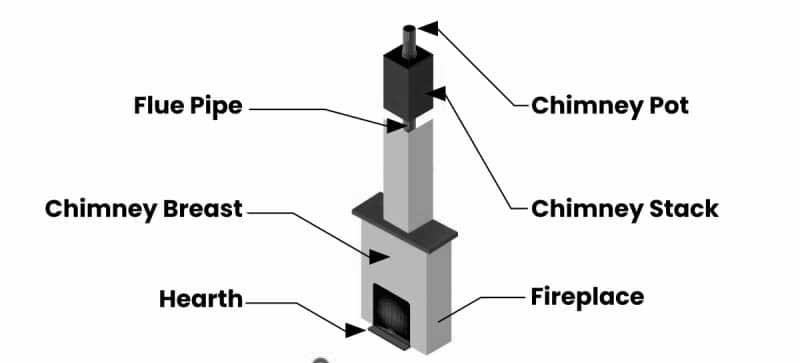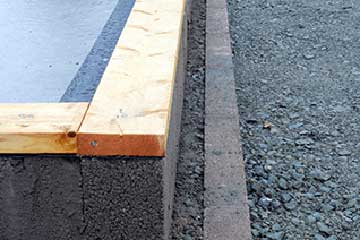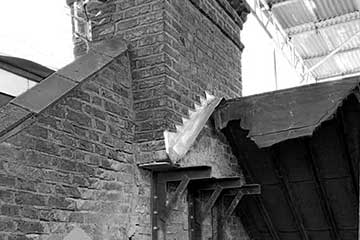What is a Chimney Breast? FAQs answered.
Are you planning to remove a chimney breast to make more room in your living room or bedroom? Or do you want to completely remove this structure because it is too expensive and damaged to be repaired? Read our guide to find out what is it and what you should do with it.
A chimney breast is the portion of a chimney that pushes forward from the wall to provide room for a fireplace. It is the brickwork that encases the chimney as it rises through the house.
It is often located on the inside of the property, taking up space within the rooms that it goes through. Normally is situated on the bottom floor of a structure, with brickwork that continues upwards and incorporates a flue to convey smoke out of the house through the exterior chimney stack.
The appearance and construction of a chimney breast vary according to the construction material, period, and functionality. The chimney breast is considered an architectural feature of the room and is used more than often as the focal point in a home.
The components of the chimney are illustrated below:
- Outside: Chimney stack, Chimney Pot
- Inside: Chimney Breast, Fireplace, and Hearth

Depending on the type of material and if it is a false chimney breast or not, a property owner can remove it. Is important to highlight that a chimney breast can provide important structural support to the property.
Therefore, a building regulation application will be needed to remove a chimney breast. A structural engineer’s designs will need to be submitted to building control prior to commencing work.
Considerations for removing a chimney breast or stack
- Is it a listed building? Or is it a conservation area? Speak to your local planning authority.
- Is the chimney breast attached to a wall between your home and another building? Speak to a party wall surveyor.
- Do any gas, plumbing or electrical appliances and services need to be removed or changed before removal? Speak with an experienced and licenced professional to do the work.
Some of the pros and cons of removing a chimney breast include:
Pros:
Removing a chimney breast can create additional space in a room. This can be especially useful if you have a small or crowded room that could benefit from some extra square footage.
Removing a chimney breast may also make it easier to rearrange the layout of a room or to add new features, such as a built-in bookshelf or an additional window.
If you no longer use your fireplace, removing the chimney breast can reduce heat loss and improve energy efficiency in your home.
Cons:
Removing a chimney breast can be a complex and costly project, especially if the chimney is structural. It may require the services of a structural engineer and specialized contractors.
Removing a chimney breast may also affect the value of your home. Some buyers may prefer a home with a working fireplace, and removing the chimney breast may make it more difficult to add a fireplace in the future.
If you live in a historic home or a neighborhood with strict architectural guidelines, you may be required to obtain special permission to remove the chimney breast. This can add additional time and cost to the project.
Overall, whether or not it is worth removing a chimney breast will depend on your specific circumstances and goals.
Need A Free Estimate?
- Fully qualified RICS professional surveyor
- Affordable, fast and thorough surveys
- Clear, precise and easy to understand report
Removing a chimney breast from a house can potentially affect the value of the property, although the impact will depend on a variety of factors. Some of the considerations include:
The demand for fireplaces: Some buyers may prefer a house with a working fireplace, and removing the chimney breast may make it more difficult to add a fireplace in the future. This aspect carries a high weight when comes to older properties, as the potential owners of this type of property are looking forward for a fireplace feature. Therefore, this could potentially decrease the value of the property.
The cost of the project: Removing a chimney breast can be a complex and costly project, especially if the chimney is structural. This could potentially decrease the value of the property, especially if the cost of the project is not fully recouped through increased property value.
The effect on the appearance of the property: Removing a chimney breast may affect the appearance of the property, especially if it is a prominent feature of the building. Probably this consideration is the one in which the subjectivity of the buyer will dictates if removing the chimney breast actually decreased the value of your home. Is all about the property appeal.
The condition of the property: If the property is in good condition and has other desirable features, the impact of removing a chimney breast on the value of the property may be less significant.
Overall, it is difficult to predict the exact effect that removing a chimney breast will have on the value of a property, especially that most of the buying process is done by the heart and “the feeling of the property” when the new potential owners visit the house.
There are several factors to consider when deciding whether it is worth removing a chimney breast in a home. Some of the key factors to consider include:
Cost: Removing a chimney breast can be a complex and costly process, especially if the chimney is structural or if it is located in a load-bearing wall.
As per latest Home Building article, the estimates for removing a chimney breast depend on the property; however, here are some figures:
Ground or first-floor chimney breast only: £1,600-2,600 plus VAT
External stack: £1,200-2,200 plus VAT
Full chimney in a two-story property: £3,200–4,200 plus VAT.
Utility: If you do not use your fireplace and do not plan to use it in the future, removing the chimney breast may make sense. However, if you do use your fireplace or are considering installing a wood stove or other heating appliance, removing the chimney breast may not be practical.
Resale value: Removing a chimney breast may affect the resale value of your home, as some buyers may see a working fireplace as a desirable feature.
Aesthetics: Removing a chimney breast may change the appearance of your home, both inside and out.
Overall, whether or not it is worth removing a chimney breast will depend on your specific circumstances and priorities. It is a good idea to carefully weigh the pros and cons before making a decision.
If you are planning to remove a chimney breast, you should check with your local planning authority to determine whether you need planning permission and to find out about any specific requirements or restrictions that may apply. You may also need to obtain building regulations approval for the work, which is a separate process from planning permission.
In some cases, you may be required to obtain special permission to remove a chimney breast, especially if you live in a historic home or a neighborhood with strict architectural guidelines. In other cases, the work may be considered “permitted development,” which means that it does not require planning permission as long as it meets certain criteria.
It is important to be aware of the planning and building regulations that apply to your property and to follow the proper procedures to ensure that the work is carried out safely and legally.
Sometimes the removal of the chimney stack is considered an option because it has been damaged beyond repair and/or is leaking. For removing a stack above the roofline, a building regulation application is not necessary.
However, removing all of the chimney stack throughout the house will need a building regulation application as the stack may support the walls, floors, or roof structure.
As before, all the considerations mentioned above need to be weighed before any work commences. Also, it is a job that can go wrong leaving problems with ventilation (the chimney is considered a passive method of ventilation), dampness, and even structural collapse if is done incorrectly.
We highly recommend employing an experienced professional to deal with this task.
Written by Danil P.
23th May 2022 (Last updated on 25th Dec 2022)
5 minute read





